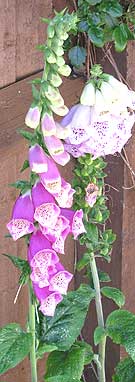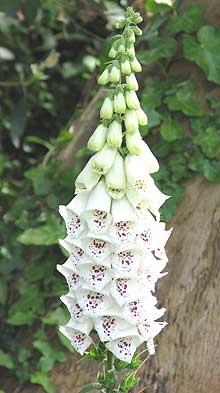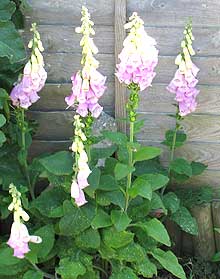Growing Foxgloves - A Popular Cottage Garden Biennial
SEASONAL TIPS FOR GROWING FOXGLOVES
Spring - Buying and planting.
Buy and plant out foxgloves while the weather is cool.
SUMMER - Staking
Support tall foxgloves if they show signs of leaning, especially if grown
for cutting.
LATE SUMMER -
Seeding
Lay spent flower stalks on the ground where you want new plants,
or sprinkle seed directly from the dried pods.
WINTER -
Mulching
Lightly mulch around the base of young plants (below). In mild areas,
leaf crowns may survive the winter, to make an early start in spring.
PLANT SOCIETIES

 The
common Foxglove, which grows wild in shady places
in Great Britain, is a familiar garden flower and particularly suitable
for planting among shrubs, in the woodland and on a shady border.
The
common Foxglove, which grows wild in shady places
in Great Britain, is a familiar garden flower and particularly suitable
for planting among shrubs, in the woodland and on a shady border.
The drooping flowers in white and various shades of rose-purple are in full beauty in June.
The Foxglove belongs to the family Scrophulariaceae.
Digitalis is from digitus, a finger, a reference to the somewhat thimble-shaped flowers.
FOXGLOVE - THE PERFECT PLANT FOR A SHADY BORDER
Foxgloves are easy to grow in ordinary soil. Once foxgloves are established in a garden they sow themselves freely every year and there is no lack of self-sown foxglove seedlings which spring up in all sorts of places.
Foxgloves should be transplanted in September-October to where they are required to flower the following year.
WHEN TO SOW FOXGLOVE SEEDS?
 The Common Foxglove (Digitalis purpurea) is
a biennial, that is to say, seeds are sown one year to provide flowering
plants the following year.
The Common Foxglove (Digitalis purpurea) is
a biennial, that is to say, seeds are sown one year to provide flowering
plants the following year.
The seeds should be scattered thinly on a nursery border in May. The seedlings, after being thinned out to give them room to grow, should be planted out finally in early autumn.
Or seeds may be scattered where the plants are to grow. A fresh stock of plants must be raised every year, unless there are self-sown seedlings.
WHERE TO PLANT FOXGLOVES?
Growing tall and straight, the foxglove makes a wonderful backdrop for other flowers, a distinctive show among the flowering shrubs, or an elegant specimen plant in the summer garden.
Plant foxgloves in groups at the back of the border with Shasta Daisy (Leucanthemum x superbum) or Peony (Paeonia) in the foreground. Or, choose perennials with round flower-heads for a stunning contrast with the foxglove’s vertical stems.
Set among flowering shrubs, the foxglove is tall enough to emerge from the crowd.
WHICH VARIETIES OF FOXGLOVE TO GROW?
Those who value the Foxglove as a garden flower should not grow the common kind, for there are varieties which are of more vigorous growth and bear flowers of finer colouring.
The Shirley strain of Foxglove is exceptionally fine, but the best of all is the Excelsior strain, in which the flowers, in various shades, are carried all round the spike.
The Gloxinia-Flowered Foxglove. The variety of Foxglove named gloxinioides or monstrosa is remarkable and often the cause of much astonishment to amateur gardeners; one large and striking flower appears at the top of the stem which otherwise bears flowers of normal size and shape. Seeds can be purchased of this variety and many of the plants will come true to type.
There is a strain or type of Foxglove called Giant Primrose which bears flowers of various shades of pale yellow, buff and cream. It is very attractive for the blooms are more conspicuous than those of the normal rose- purple shades.
Of the true species or wild types of Foxglove, Digitalis ambigua, yellowish; D. ferruginea, reddish; and D. lutea, yellow, all short-lived perennials but easy to raise from seed, are noteworthy.
GARDENING ARTICLES ON GARDEN GROWER
How to grow foxgloves- a favourite flower for the cottage garden. Expert advice on seasonal care and growing tips on growing a foxglove plant from seed or young plants.